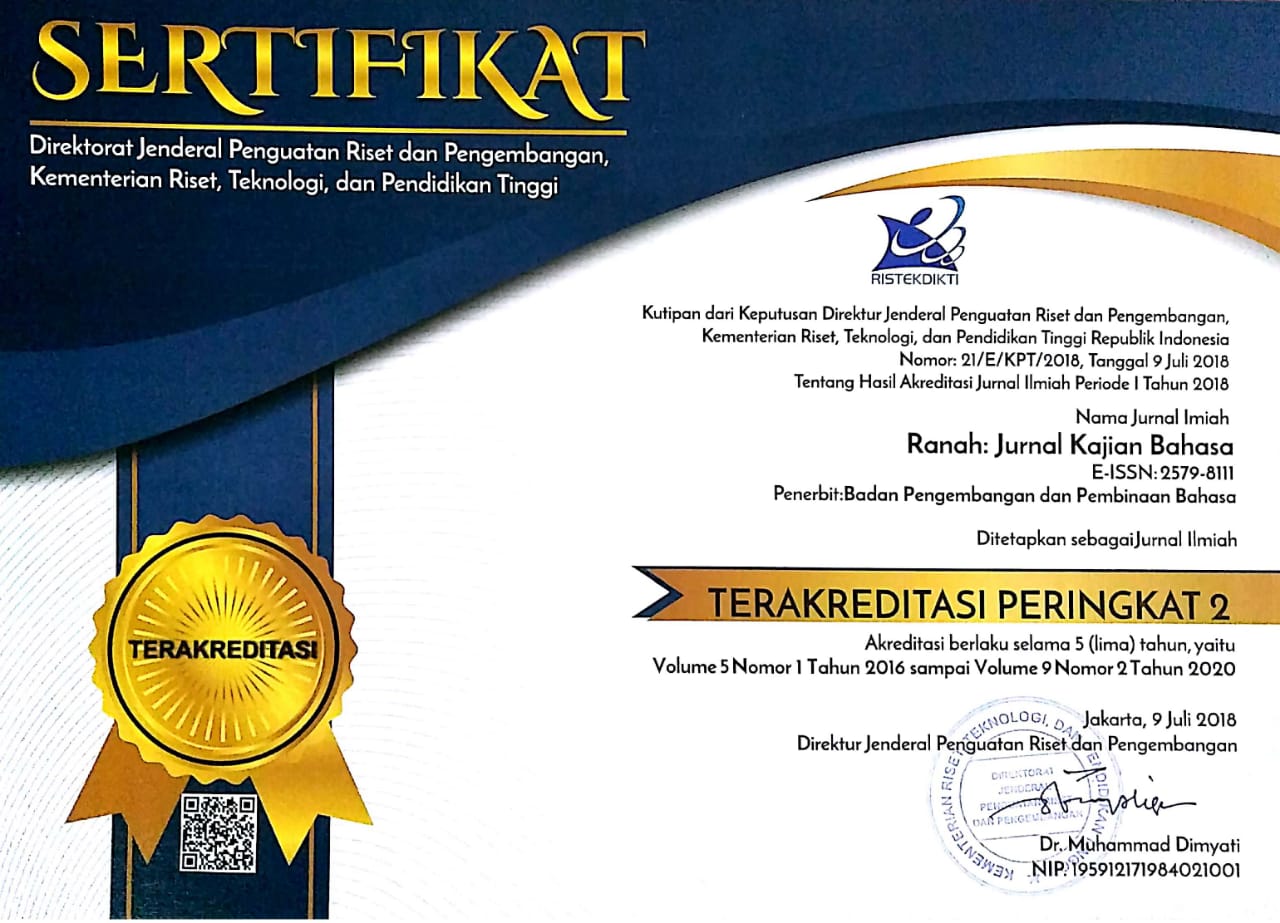Tinjauan Pragmatik Siber Pada Acara Virtual Doa Lintas Agama Pray from Home untuk Mengatasi Pandemi Covid-19
Abstract
The purpose of this study is to explain the government's role in overcoming the Covid-19 problem through the socialization of PrayfromHome as an effort to improve ways to improve themselves in increasing the immunity of religious communities. This was done because a vaccine for the Covid-19 virus has not yet been found. To find out the role of the government, the researchers conducted data collection based on the propositions contained in the virtual joint editorial prayer offered by policy makers and representatives of interfaith prayer. The method used in this research is a qualitative research based on cyber pragmatics based on each thematic content contained in the editorial propositions of the prayers offered. The results of the study show that Pray from home activities have thematic content which is divided into (1) from the policy makers, the Covid-19 outbreak requires every religious adherent to provide physical and mental enthusiasm as an initial provision of intangible vaccines for the Indonesian people, (2) from the representative side of inter-religious prayer that raises several inner conditions, including (a) there are several acknowledgments of mistakes for all actions carried out in the world to the Creator before asking for the world to return to normal, (b) the existence of a form of superiority of God's natural power, as the greatest power, a place to surrender, (c) hope for all parties involved or at the forefront in handling the Covid-19 pandemic so as not to provide strength and safety during the handling process.
Abstrak
Tujuan dari penelitian ini adalah untuk menjelaskan peran pemerintah dalam mengatasi permasalahan Covid-19 melalui sosialisasi doa bersama PrayfromHome sebagai upaya meningkatkan keimanan yang berujung pada peningkatan imun umat beragama. Hal itu dilakukan karena vaksin dari virus Covid-19 belum ditemukan. Untuk mengetahui peran pemerintah tersebut, peneliti melakukan pengambilan data berdasarkan proposisi-proposisi yang terdapat dalam redaksional doa bersama secara virtual yang dipanjatkan oleh pemangku kebijakan dan perwakilan pendoa antaragama. Metode yang digunakan dalam penelitian ini adalah penelitian kualitatif berbasis analisis pragmatik siber berdasarkan setiap muatan tematik yang terdapat dalam proposisi-proposisi redaksional doa yang dipanjatkan. Hasil penelitian menunjukkan kegiatan Pray from Home memiliki muatan tematik yang terbagi atas (1) dari sisi pemangku kebijakan, adanya wabah pandemi Covid-19 ini mengharuskan setiap pemeluk agama untuk memberikan penguatan diri secara fisik maupun mental sebagai bekal awal vaksin tak benda bagi masyarakat Indonesia, (2) dari sisi perwakilan pendoa antaragama yang memunculkan beberapa kondisi batiniah, di antaranya (a) terdapat beberapa pengakuan kekhilafan atas segala perbuatan yang dilakukan didunia kepada Sang Pencipta sebelum meminta agar dunia kembali seperti sediakala, (b) adanya bentuk superioritas kekuatan alami Tuhan, sebagai kekuatan terbesar, tempat memasrahkan diri, (c) terselipkan harapan kepada semua pihak yang terlibat atau garda terdepan dalam penanganan pandemi Covid-19 agar diberikan kekuatan serta keselamatan selama proses penanangan wabah berlangsung.
Keywords
Full Text:
PDF (Bahasa Indonesia)References
Campbell, Heidi dan Ruth Tsuria. (2022). Digital Religion: Understanding Relogous Practic in Digital Media. New York: Routledge. https://doi.org/10.4324/9780429295683
Clark, Herbert H. dan Clark, Eve V. (1977). Psychology and Language: An Introduction to Pasycholinguistics. New York: Harcourt Brace and Jovanovich, Inc.
Coulthard, Malcolm. (1979). An Introduction to Discourse Analysis. London: Longman Group Limited.
Creswell. (2013). Penelitian Kualitatif dan Desain Riset: Memilih di Antara Lima Pendekatan. Yogykarta: Pustaka Pelajar.
Dardjowidjojo, S. (2000). Echa Kisah Pemerolehan Bahasa Anak Indonesia. Penerbit Universitas Katolik Indonesia Atma Jaya.
Dardjowidjojo, S. (2003). Psikolinguistik: Pengantar Pemahaman Bahasa Manusia. Yayasan Pustaka Obor Indonesia.
De Saussure, Ferdinand. (1993). Pengantar Linguistik Umum. Yogyakarta: Gadjahmada University Press.
Edmondson, Willis. (1981). Spoken Discourse: A Model for Analysis. London: Longman Group Limited.
Fairclough, Norman. 1989. Language and Power. London: Longman.
George, Pattison. (2020). Thinking about God in an Age of Technology. download. (n.d.). Retrieved February 20, 2022, from https://en.id1lib.org/book/611449/d0a56b
Gorter, D. (2006). Introduction: The Study of The Linguistic Landscape as a New Approach to Multilingualism. International Journal of Multilingualism, 3(1), 1-6. https://doi.org/10.1080/14790710608668382
Gumperz, John J. Dan Dell Hymes. (1972). Directionsof Sociolinguistics. New York: Holt, Rinehart, and Winston Inc.
Gumperz, John. (1982). Discourse Strategies. New York: Cambridge University Press. https://doi.org/10.1017/CBO9780511611834
Halliday, M. A. K. (1994). An Introduction to Functional Grammar. London: Edward Arnold.
Helland, C. (2016). Digital religion. In Handbook of Religion and Society (pp. 177-196). Springer, Cham. https://doi.org/10.1007/978-3-319-31395-5_10
Hidayah, A. R. (2021). Theorization the Use of Podcasts as an Alternative Medium of Da'wah and its Impact on the Audience: The Case of Indonesia. Pertanika Journal of Social Sciences and Humanities, 29(4), 2635-2651. https://doi.org/10.47836/pjssh.29.4.29
Hine, C. (2008). Virtual Ethnography: Modes, Varieties, Affordances. The SAGE handbook of online research methods, 257-270. https://anthropolojamz.wordpress.com/2015/09/06/hine-virtual-ethnography-modes-varieties-affordances/
https://doi.org/10.4135/9780857020055.n14
Hymes, D. (2013). Foundations in Sociolinguistics: An Ethnographic Approach. Foundations in Sociolinguistics: An Ethnographic Approach, 1-247. https://doi.org/10.4324/9781315888835
Indick, W. (2015). The Digital God: How Technology Will Reshape Spirituality. McFarland.
Kress, Gunther. (2009). Multimodality: A Social Semiotics Approach to Social Contemporary Communication. London: Routledge. https://doi.org/10.4324/9780203970034
Ong, Walter J. (2013). Kelisanan dan Keberaksaraan. Yogyakarta: Gading.
Orsini-Jones, M., & Lee, F. (2018). Intercultural Communicative Competence (ICC) Revisited. Intercultural Communicative Competence for Global Citizenship, 7-23. https://doi.org/10.1057/978-1-137-58103-7_2
Pesantren, I., & Chalim, K. A. (2022). Konsep Pembelajaran Pendidikan Agama Islam di Era Society 5.0. Edupedia : Jurnal Studi Pendidikan dan Pedagogi Islam, 6(2), 133-145. https://doi.org/10.35316/edupedia.v6i2.1592
Pranowo, N. F. N., & Firdaus, W. (2020). Penggunaan Bahasa Nonverbal dalam Upacara Adat Pernikahan Gaya Yogyakarta: Kajian Simbolik Etnopragmatik. Ranah: Jurnal Kajian Bahasa, 9(1), 35-55.
Rahardi, K. (2020). Konteks Pragmatik dalam Perspektif Cyberpragmatics. Linguistik Indonesia, 38(2), 151-163. https://doi.org/10.26499/li.v38i2.132
Locher, M. A. (2013). Relational Work and Interpersonal Pragmatics. Journal of Pragmatics, 58, 145-149. https://doi.org/10.1016/j.pragma.2013.09.014
Schiffrin, Deborah. (1994). Approaches to Discourse. Oxford, UK, Cambridge: B
Searle, John R. 1983. Speech Acts: An Essay in The Philosophy of Language. Cambridge: Cambridge University Press.
Sudikan, Setya Yuwana, Titik Indarti, dan Ardi Wina Saputra. 2021. Etnografi Komunikasi (Jilid 2). Lamongan: Tankali.
Suyitno, Imam. (2005). Proposisi Bentuk Kosong dalam Wacana Slogan: Kajian Tindak Tutur Wacana Slogan. Jurnal Humaniora, 17(1).
Spradley, James P. 2006. Metode Etnografi. Yogyakarta: Tiara Wacana.
Thomas, L., & Wareing, S. (2020). Attitudes to language. Language, Society and Power, 193-208. https://doi.org/10.4324/9780203426968_chapter_11
Widiana, Y. (2020). Tindak Tutur Fatis dan Realisasi Kesantunannya dalam Ranah Pertemanan di Kalangan Mahasiswa Jawa di Madiun. Doctoral dissertation: UNS (Sebelas Maret University).
Yus, F. (2011). Cyberpragmatics: Internet-Mediated Communication in Context. John Benjamins Publishing Company. https://doi.org/10.1075/pbns.213
Zoest, Aart van. (1993). Semiotika. Jakarta: Yayasan Sumber Agung.
DOI: https://doi.org/10.26499/rnh.v11i2.5195
Refbacks
- There are currently no refbacks.








